A social and cultural anastylosis rises up on the slopes of the Gran Sasso. Between restored architectures and others encircled by wooden and iron scaffolding, the shuddering echo of history alternates with ancient, modern and contemporary art. Never before has an open-air construction site mixed gravel with aesthetic media, a synesthesia of colours, shapes and encounters between what was and what will be.
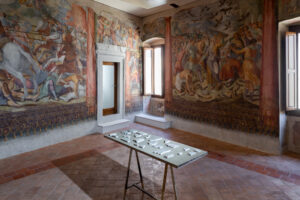
Panorama L’Aquila, 2023. Anri Sala. Ph. Luca M. Fontana, Alessio Tamborini. Courtesy ITALICS and the artist and Alfonso Artiaco
«Memory and community are pivotal words for L’Aquila, words that refer to history, culture, places and people». This is the introductory phrase with which curator Cristiana Perrella opened Panorama L’Aquila, the third event of the Italian diffuse exhibition promoted and conceived by Italics. For the four-day event, twenty location were chosen in the Abruzzo capital to host 103 works, created by 61 different artists, represented by a total of 56 member galleries. The opportunity was seized by the L’Aquila community with enthusiasm – thanks to the fine weather and fresh mountain air – to emphasise the importance of their culture and history, to remove (if only for a moment) the painful label of the devastating earthquake that struck them back in 2009.
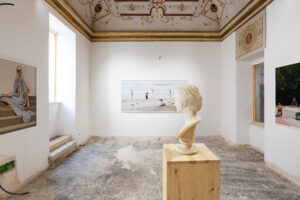
Panorama L’Aquila, 2023. Carlo Albacini, Eleanor Antin. Ph. Luca M. Fontana, Alessio Tamborini. Courtesy ITALICS and the artist and the galleries
This is a lasting rebirth, desired as a synonym for urban regeneration, also for the recent candidature as Italian Capital of Culture 2026. An active population that contributed to the fine-tuning of every host venue, from the palaces to the bookshops, passing through the cafés that hosted debates between professionals and non-professionals, with the Auditorium del Parco allowing contemporary art-themed films to be shown. There was no lack of total openness on the part of the institutions, and all the members of Italics increased their interest outside of market logics, to grow as a unity and an aesthetic community. This mood was further confirmed by the curatorial logic of Cristiana Perrella, who started from the suggestion of the term wit(h)nessing, coined by the feminist theorist, artist and psychoanalyst Bracha L. Ettinger, which extends the concept of witnessing from the individual to the collective and participatory dimension. Placing works by established, mid-career and emerging artists within the walls and squares of L’Aquila was undoubtedly a challenge overcome with flying colours. The fascinating mixture of fully and partially restored elements with the workmanship of the artworks presented was studied with empathetic attention, to emphasise memories and visions.
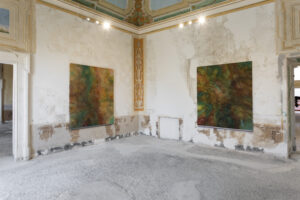
Panorama L’Aquila, 2023. Pascale Marthine Tayou. Ph. Luca M. Fontana, Alessio Tamborini. Courtesy ITALICS and the artist and Galleria CONTINUA
Mention must undoubtedly go to the 16th century Rivera Palace. A conspicuous number of artworks were stored among the stucco and Rococo ceiling frescoes and the white walls in continuum with the rough reconstructed floor. Antique, modern and contemporary alternated in each room, like a sequence of gallery rooms: passages of style and language like skips on a personal playlist. Shots by Eleanor Antin (Richard Saltoun Gallery) mirrored a sculpture of a falling angel attributed to a Neapolitan sculptor from the circle of Luca Giordano (Botticelli Antichità), hovering over the contemporary notes of Beatrice Marchi (Federico Vavassori). If a neon installation by Yael Bartana (Galleria Raffaella Cortese) emphasised the cultural division, Gianni Caravaggio‘s flag (kaufmann repetto) – a twin of which was donated to the city of L’Aquila as a permanent work – sang the praises of community unity.
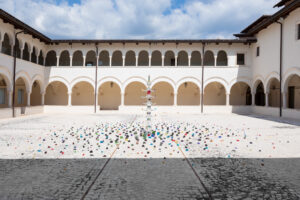
Panorama L’Aquila, 2023. Pascale Marthine Tayou. Ph. Luca M. Fontana, Alessio Tamborini. Courtesy ITALICS and the artist and Galleria CONTINUA
A location embellished by a site-specific work was the courtyard of the Corte dei Conti with Pascale Marthine Tayou‘s multicoloured totem pole (Galleria Continua), while the Casino delle Delizie Branconio saw its frescoed room of the caravaggesque school the addition of fragments by Anri Sala (Alfonso Artiaco). The shop window of the historic Caffè Fratelli Nunzia in front of the reborn Piazza Duomo displayed sculptures by Alek O. (Martina Simeti), while the Libreria Polarville hung five canvases by Diego Gualandris (ADA).
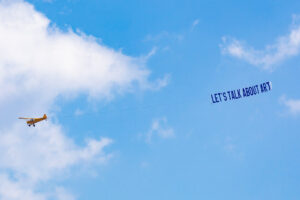
Panorama L’Aquila, 2023. Maurizio Nannucci. Ph. Luca M. Fontana, Alessio Tamborini. Courtesy ITALICS and the artist and Galleria Fumagalli
MAXXI L’Aquila and MuNDA’s Mammoth Hall were also the venues for a number of works conceived for Panorama, but contrary to what was stated in the press kit, admission was not free. And among these and other venues where art took on splendour, without detracting from the sensitive performances among the construction sites and deconsecrated churches, one in particular ‘took flight’. The work by Maurizio Nannucci (Galleria Fumagalli) flew over the entire centre of Abruzzo with the words LET’S TALK ABOUT ART in large letters, perfectly describing the sensation experienced during all the days of the widespread exhibition.There was a before, a during and an after Panorama L’Aquila. Art was talked about imagining the challenge that awaited Italics with Cristiana Perrella, after the dazzling Procida and Monopoli editions with Vincenzo de Bellis. We talked about art thanks to the people who worked on this project and thanks to the multitude of people who flocked to a land full of memory, history and culture. Art was spoken of at the close of the four days because there was a participatory importance derived from art itself.
Info:
A.A.V.V. Panorama L’Aquila
07 – 10/09 2023
curated by Cristiana Perrella
ITALICS
L’Aquila (AQ)
https://italics.art/panorama-laquila/
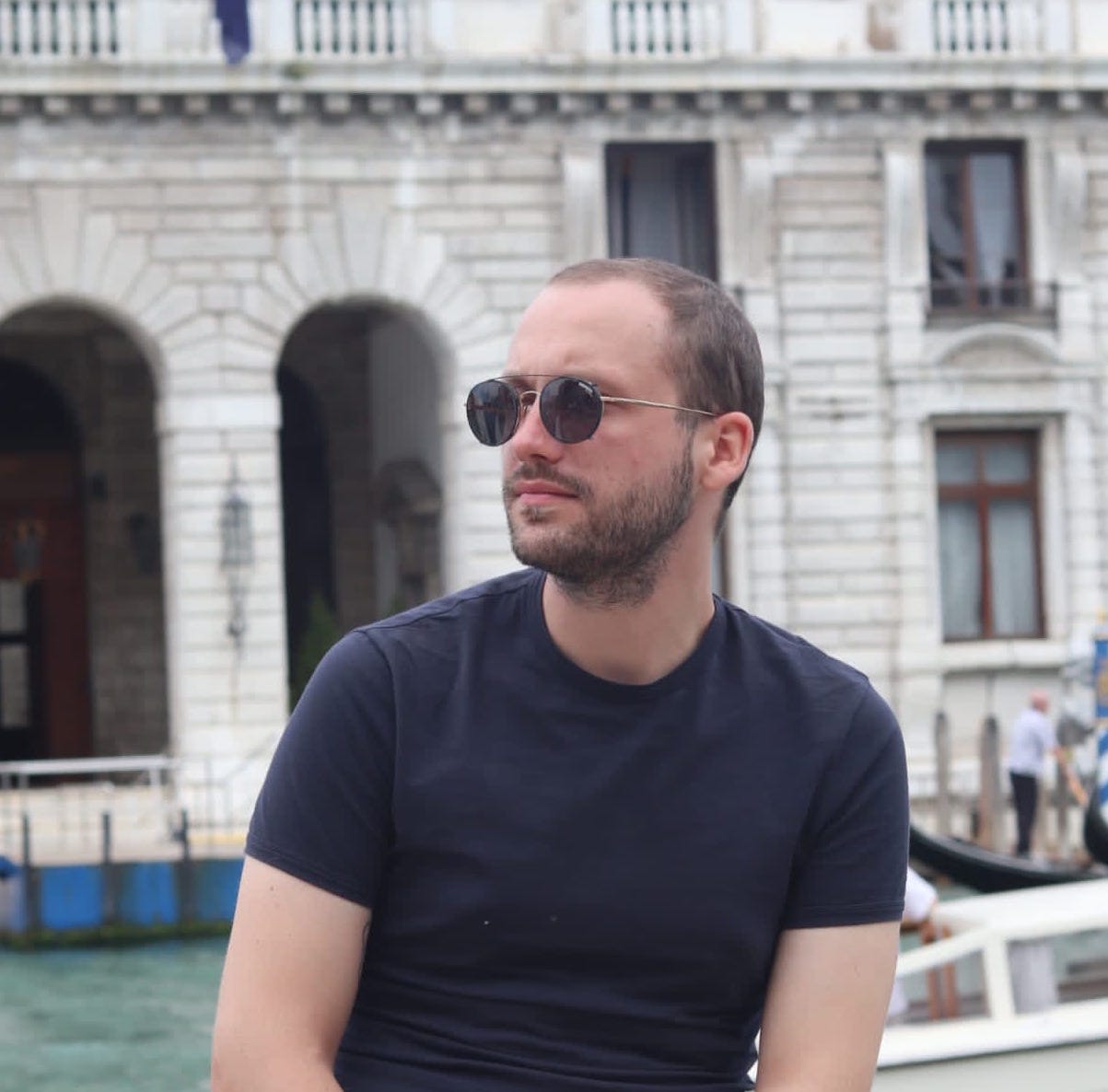
Art Curator and Art Advisor, graduated in Visual Arts and Cultural Mediation, with Master in Curatorial Practices, born in 1995, lives in Naples. He collaborates with Galleries and Independent Spaces, his research is mainly focused on Emerging Painting, with a careful and inclined gaze also on other forms of aesthetic language.






NO COMMENT